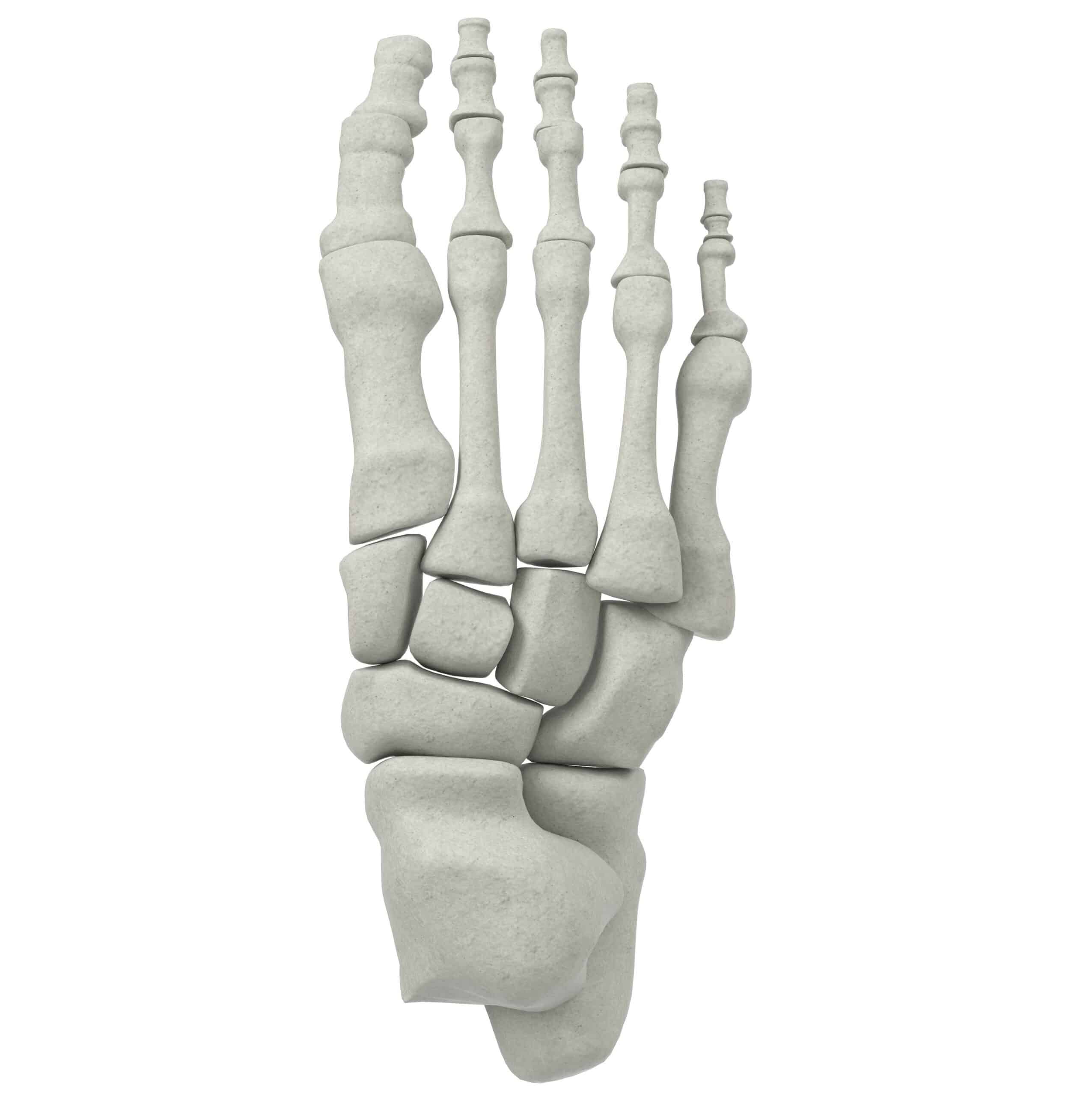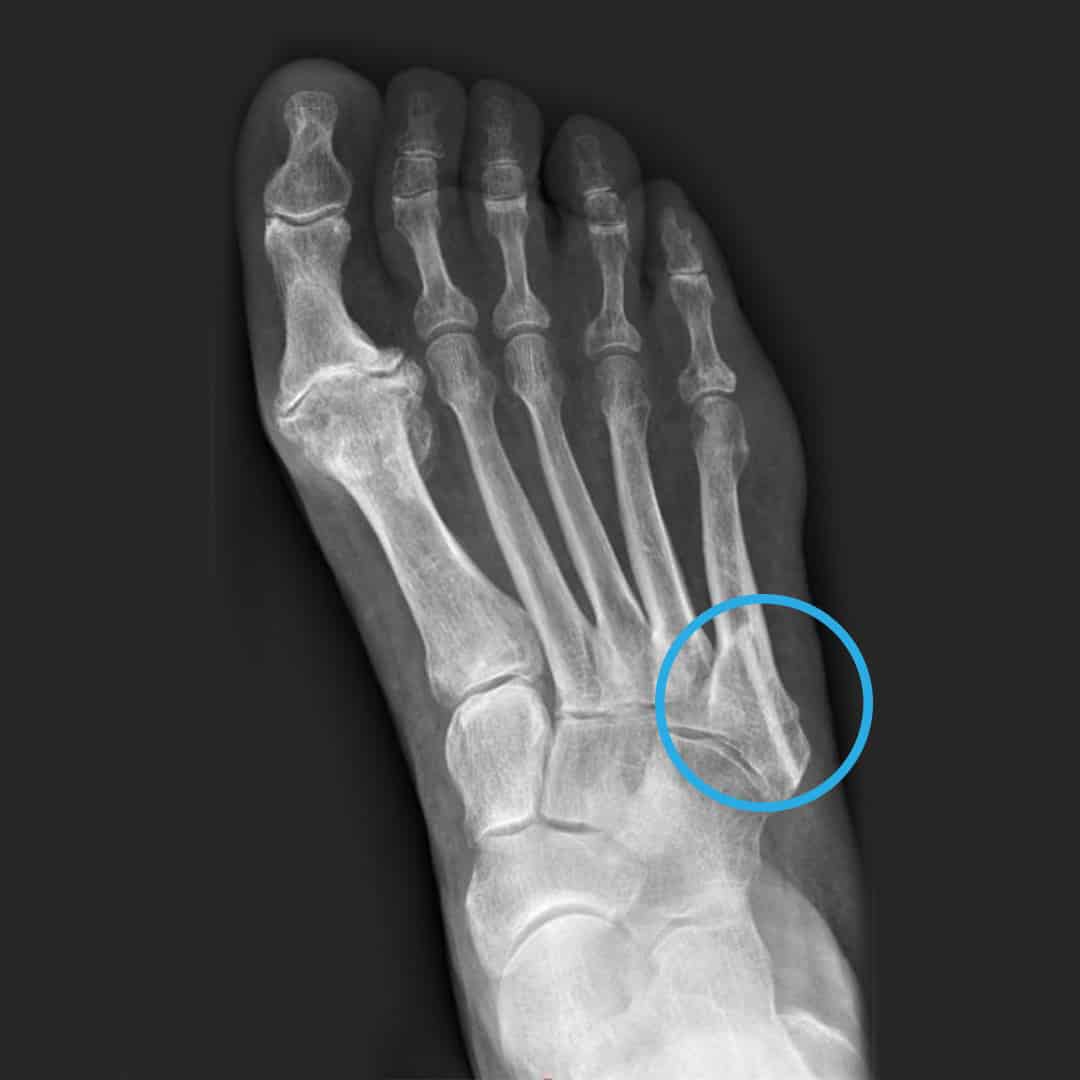In this guide you will find everything you need to know about metatarsal fractures. Expert Dr. Klaus Pastl explains what symptoms indicate a metatarsal fracture, how it should be treated, why you as a patient should undergo surgery with screws made from human bone. If you have suffered a metatarsal fracture, here are further links to experts in your area who can provide you with 100% biological Shark Screw®, a screw made of bone.
Reading time: 5 min
Table of Contents
What is a metatarsal fracture?
A metatarsal fracture involves the fracture of one or more metatarsal bones, also called the ossa metatarsalia. A distinction is made here between traumatic fractures (accidents & violent impacts), fatigue fractures of the metatarsus and pathological fractures of the metatarsus (triggered by osteoporosis). Symptoms of the metatarsal fracture are usually pain on exertion or swelling in the affected regions. Athletes are the most frequently affected.
Metatarsal fractures account for about one-third of all foot fractures. The most commonly fractured metatarsal is the 5th metatarsal – this fracture is also called a Jones fracture. It often happens that not only one of the 5 metatarsal bones, but several are broken.
The metatarsals are numbered from 1 to 5 from the inside out.

The Jones Fracture / 5th Metatarsal Fracture
The Jones fracture is a fracture of the 5th metatarsal – a fracture at the junction of the diaphysis and metaphysis. The diaphysis refers to the bone shaft and the metaphysis to the narrow area between the bone shaft and the epiphysis (end of the bone). A Jones fracture can occur when the foot is turned in during toe-off and is twisted. Soccer players, in particular, often suffer a Jones fracture when they are hit by a foreign object. This can happen due to a blow from the opponent on the outside of the foot. Not all Jones fractures require surgery. If Jones fractures are operated on, then screws made from human bone, such as Shark Screw® have proven to be well suited.
What are the symptoms of a Jones fracture?
The most noticeable symptoms of the Jones fracture include severe pain around the outer edge of the foot. However, it may well be that at the beginning of the fracture there is no discomfort at all and patients remain pain-free for some time. However, in the case of an acute fracture, the symptoms occur immediately.
Further, in the case of a Jones fracture, the foot is very sensitive to touch and may show swelling. In addition, those affected often suffer from restricted mobility and may adopt relieving postures.
What are the causes of a Jones fracture?
Most often, a Jones fracture is caused by excessive stress. If the cause is specifically an overload, the fracture is called a fatigue fracture or stress fracture. Patients suffering from osteoporosis are particularly susceptible.
In most cases, the bone in a Jones fracture breaks at the point of the bone with the least blood supply, which means that the Jones fracture has an extremely poor healing potential. Most susceptible to Jones fractures are usually athletes but also young soldiers. Since the affected areas are often poorly supplied with blood, screws made of bone, such as Shark Screw®, have proven effective. Due to the biology of the screw made of bone, rapid blood flow and healing is possible.
Jones Fracture Treatment & Diagnosis
The conservative therapy of the Jones fracture
An X-ray is performed to diagnose a Jones fracture. Due to the poor blood supply to the metatarsal bones, healing and immobilization of the Jones fracture may well take longer. In conservative therapy, the foot is initially immobilized in a plaster shoe for 6 weeks. The patient is usually allowed to put full weight on the foot. After removal of the cast, the Jones fracture must be supported with fixative dressings until the fracture is completely healed.
The operation of the Jones fracture
The Jones fracture is treated surgically if the fracture is displaced by more than 5 millimeters. Screws made from human bone are usually used. Athletes in particular are advised to undergo this surgery to speed up healing. Surgery is also required if the Jones fracture has not healed after conservative therapy. In this case, one speaks of a pseudarthrosis. Pseudarthrosis can usually be cured by surgery with screws made from human bone.
What are symptoms of a metatarsal fracture?
Pain in the metatarsal area is a typical sign of a metatarsal fracture. In the Jones fracture, the fracture of the 5th metatarsal, the pain is expressed more in the area of the edge of the foot. In addition, a pressure pain is felt with all fractures of the metatarsal bones. Swelling and restricted movement of the foot are accompanying symptoms. Bruises (hematomas) may also form over the midfoot and down to the toes. Have pain in the foot clarified quickly by a specialist. Not every fracture is accompanied by swelling.
Treatment of metatarsal fracture
The goal of treatment for a metatarsal fracture is to be able to move the foot again as soon as possible without pain and under weight bearing. Here, the type of treatment depends on the type of metatarsal fracture. After initial treatment by a physician, an x-ray will reveal how severe the injury is. Non-displaced fractures (non-displaced fractures) can often be treated conservatively, i.e. without surgery. If the fracture is more displaced (dislocated fracture), surgery will be necessary to treat the metatarsal fracture in most cases.
Conservative treatment vs. surgical treatment of metatarsal fracture
If the fracture is not displaced, conservative treatment is recommended. The advantages of conservative therapy: the patient is spared surgery and the associated risks. Disadvantage: Only non-displaced fractures can be treated conservatively and the time to regain full range of motion is usually 4 – 10 weeks. There is a risk of pseudarthrosis, i.e., failure of the fracture to heal. Surgery is considered if the fracture fragments are too far apart or displaced. Screws made from human bone have proven effective for restoration.
The Shark Screw® for metatarsal fractures
Shark Screw®, a screw made from human bone, is now considered the center of choice for the Jones fracture per se but also for metatarsal fractures. Screws made from human bone have replaced screws made from metal as they were used in the past. The reason: screws made from human bone are integrated into the natural bone remodeling process and converted into the patient’s own bone within a few months. A so-called restitutio ad integrum takes place. The biggest advantage for patients is that no foreign material remains in the body. Each patient is thus spared the second operation for the removal of the metal. It is therefore a 100% biological osteosynthesis.
Metatarsal fracture complication
Any fracture can also bring severe complications, and it is the same with the metatarsal fracture. If a comminuted fracture is present, there is a risk that the individual bone fragments will not heal sufficiently. The result: a splay foot or flat foot can develop. If the cartilage is additionally damaged during the fracture, arthrosis can form in the affected joint. Pseudarthrosis can also occur with a Jones fracture, which means that the bone parts no longer grow together completely. If the metatarsal fracture also has crush injuries, there is a risk of the occurrence of compartment syndrome.
Aftercare of the metatarsal fracture: Accelerate healing
Bone usually takes 4 – 6 weeks to heal. During this time, driving should also be avoided. To speed up the healing process, it is important to follow the instructions of the treating physician and not to put too much weight on the foot too soon. You should use crutches for as long as your treating physician recommends. In addition, the application of special ointments and creams relieves swelling on the foot. In addition, a calcium-rich diet can positively influence the fusion of bone fragments. Lymphatic drainage and physiotherapy accelerate the healing of a metatarsal fracture. After a healed metatarsal fracture, it is recommended to wear shoes with a hard sole.

The author - Dr. Klaus Pastl
Dr. Klaus Pastl is a specialist in orthopedics and orthopedic surgery in Linz / Austria & an expert in operations with the bone screw, the Shark Screw®. Dr. Klaus Pastl has many years of experience and can look back on over 13,000 operations.







